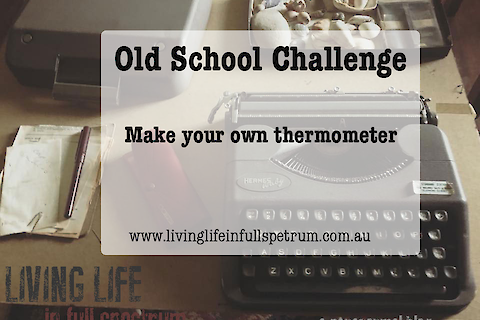

Old School Challenge: Make your own thermometer
Cold spots, hot spots, temperature changes are quite a common discussion amongst paranormal investigators. It seems to be the general theory that spirits create what is referred to as cold spots. While there are a lot of natural explanations for this which you can find in my article: Cold Spots and the paranormal, people still record temperature and more important temperature changes within the environment to see if there are any large fluctuations around the same time that unusual activity occurs.
In modern-day paranormal investigation, people traditionally use a laser IR temperature gun. The problem with this is that the laser has to hit an endpoint which means it measures the surface and not a mist of air' which is really what we would assume a cold spot to be. Data loggers and Mel Meters seem to be a better fit to measure this kind of phenomenon. If your pockets are deep enough, you may even use a thermal camera to get a visual of where these cold spots may be and where they are coming from. But what did investigators use to do before these were invented? In some cases, people would carry around cheap thermometers you would buy from the store which are filled with mercury. Mercury itself can be quite dangerous, especially if the thermometer were to break as it is made of glass. People instead would use an alcohol-based thermometer which ironically was called a 'spirit thermometer' as the alcohol was thought to be less toxic and dangerous should the thermometer break. So for this old school challenge, we will make an appropriately named spirit thermometer.

How does a thermometer work?
A thermometer consists of a glass tube that is sealed at both ends. It is partly filled with either mercury or alcohol-based solution. At the surrounding temperature around the bulb heats up, this heat causes the liquid inside to expand and rise up inside the thermometer. The glass tube is typically mounted on a piece of board or it has numbers printed on the tube itself which indicate the actual temperature. In simple terms, the hotter the surroundings, the more the liquid will expand and rise. As it gets colder, the liquid shrinks. While it is too difficult for us to make a proper thermometer that will accurately read the current temperature, the point of this exercise is more to detect a significant change in temperature and that is the kind of thermometer we will be making.
How to make a 'spirit' thermometer
(That is what it is actually called because of the alcohol component!)
Equipment you will need:
- empty glass bottle
- food colouring
- modeling clay
- clear straw
- 1/2 cup of rubbing alcohol
- 1/2 cup of tap water
- Pour equal amounts of tap water and rubbing alcohol into the bottle until it's around 1/4 full.
- Add a few drops of the food colouring of your choice, and shake the bottle to mix it. Red is usually the colour of choice but it can be anything you want!
- Insert the straw into the bottle, not letting it sink to the bottom.
- Wrap modeling clay around part of the straw and the opening of the bottle to make it stay. It is important to let part of the straw stick out of the bottle. The clay should be tight around the straw and cover the bottle mouth, but leave the top opening of the straw uncovered.
Using a Black marker, draw a line that will be your baseline point. This baseline point allows you to see if there have been any changes. For this reason, a whiteboard marker is ideal as it means you will be able to change your baselines every time you go into a new area. While this won't tell you the actual temperature, it will show you if there have been any significant increases or decreases in temperature.

Image Source: Scientific American
This method is not as fast as a Mercury thermometer and yes it has it flaws, but this is how an investigator may have done these measurements in the past. This is better-left stationery in a room and is not really for walking around. Investigations were a lot different before technology was invented and a lot of the technique involved was 'locking' down a room! Technology has advanced since then and of course, we now have devices like Mel Meters which can do this much easier. If anything this is more just a fun exercise to try and would be interesting to measure against an actual thermometer and against any digital devices you are using the measure the information as well to see how well they marry up!
If you enjoy LLIFS, consider buying me a book (otherwise known as buy me a coffee but I don't drink coffee and I LOVE books). Your donation helps to fund the LLIFS website so everyone can continue to access great paranormal content and resources for FREE!

Top pages with similar subjects
Don't forget to follow the Facebook page for regular updates
Join the mailing list to receive weekly updates of NEW articles. Never miss an article again!
Buy the latest and past issues Haunted Magazine
Check out the books written by LLIFS